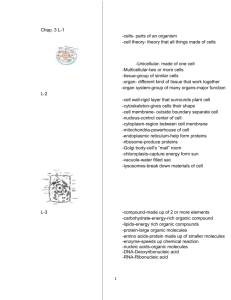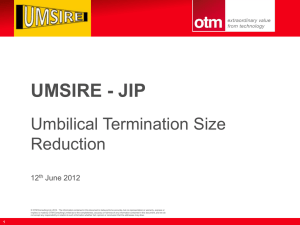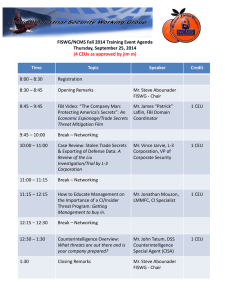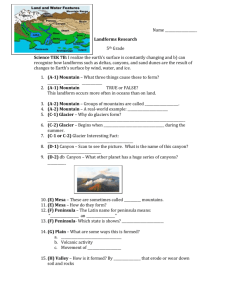Self-Assessment_Workbook_for_Schools
advertisement
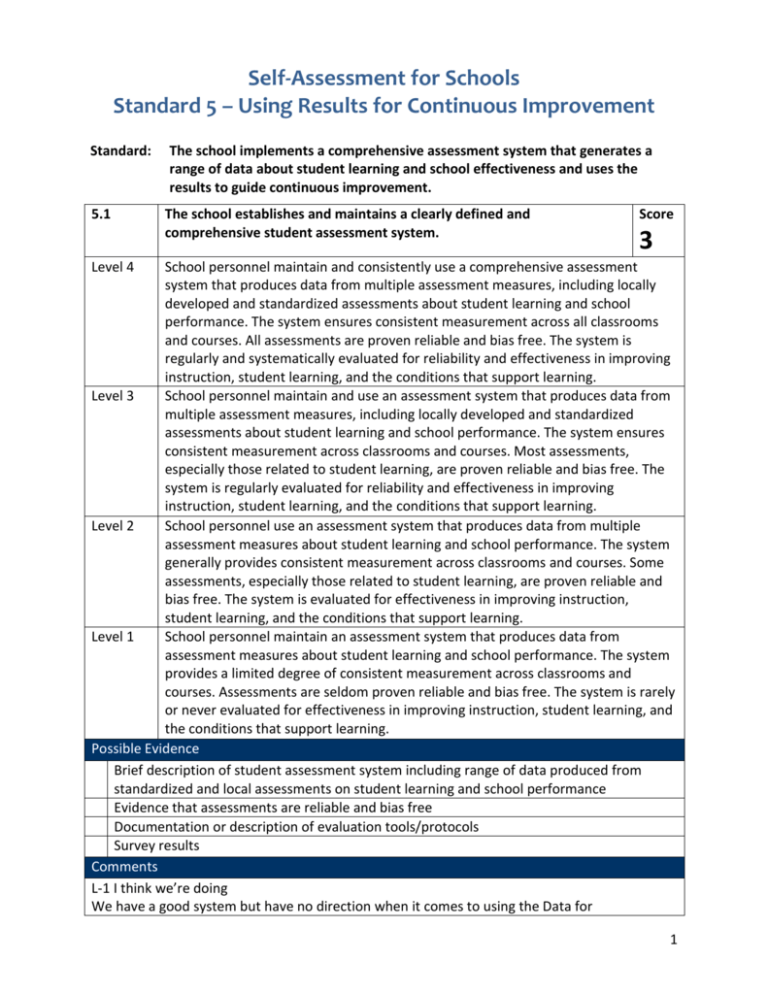
Self-Assessment for Schools Standard 5 – Using Results for Continuous Improvement Standard: The school implements a comprehensive assessment system that generates a range of data about student learning and school effectiveness and uses the results to guide continuous improvement. 5.1 The school establishes and maintains a clearly defined and comprehensive student assessment system. Score 3 Level 4 School personnel maintain and consistently use a comprehensive assessment system that produces data from multiple assessment measures, including locally developed and standardized assessments about student learning and school performance. The system ensures consistent measurement across all classrooms and courses. All assessments are proven reliable and bias free. The system is regularly and systematically evaluated for reliability and effectiveness in improving instruction, student learning, and the conditions that support learning. Level 3 School personnel maintain and use an assessment system that produces data from multiple assessment measures, including locally developed and standardized assessments about student learning and school performance. The system ensures consistent measurement across classrooms and courses. Most assessments, especially those related to student learning, are proven reliable and bias free. The system is regularly evaluated for reliability and effectiveness in improving instruction, student learning, and the conditions that support learning. Level 2 School personnel use an assessment system that produces data from multiple assessment measures about student learning and school performance. The system generally provides consistent measurement across classrooms and courses. Some assessments, especially those related to student learning, are proven reliable and bias free. The system is evaluated for effectiveness in improving instruction, student learning, and the conditions that support learning. Level 1 School personnel maintain an assessment system that produces data from assessment measures about student learning and school performance. The system provides a limited degree of consistent measurement across classrooms and courses. Assessments are seldom proven reliable and bias free. The system is rarely or never evaluated for effectiveness in improving instruction, student learning, and the conditions that support learning. Possible Evidence Brief description of student assessment system including range of data produced from standardized and local assessments on student learning and school performance Evidence that assessments are reliable and bias free Documentation or description of evaluation tools/protocols Survey results Comments L-1 I think we’re doing We have a good system but have no direction when it comes to using the Data for 1 improvement. L-1 Limited dress across classrooms, courses. L-1 More consistency in evals needed. L-2 inconsistent eval. No follow-up L-2 How would I know if an assessment is proven reliable and bias free? L-2 Time needs to be “made” for teachers to actually look at this data. L-2 Not a lot of time spent reviewing assessments at the faculty level. L-2 Need to develop a consistent measuring system which address our goals and interventions. L-2 A system is in place but does not provide measurement across classrooms but grade level and courses. L-2 Teachers apply any type of assessment deemed necessary. How: Have more teachers use the tests created by the publishers if possible. L-2 We do not test all subjects only core classes and then some core classes are only tested once. L-2 Why: Even local writing assessment grading is inconsistent even if 2-3 people grade it. L-2 Why: We agree that the assessment do not test what we teach at the grade level. How: Use a different test or change what we teach at the different grades. How: EDA for writing assessment grading. Keep the same graders. L-2 Need more consistency. L-3 Why: TerraNova and other testings ensure students continue to meet standards. How: Continue to research various testings for those best suited to Guam. L-3 The utilization of data to make inferences and conclusions are very effective and should be continued. L-3 Why: Assess. Related to student learning and bias free. How: Spend more time on creating the math assessment. L-3 We have multiple assessments-including TerraNova, SRI, PSAT, Local writing test, end of course, STAMP, etc. CSI team regularly evaluates. Need more teacher involvement. L-3 Why: Because we have assessments based on our goals. How: Local assessments need to be systematically evaluated for appropriateness. L-3 The school does use an assessment in improving instruction, student learning and the conditions that support learning. L-3 As a faculty we review and discuss standardized and Local assessment scores to brainstorm strategies to improve scores. L-3 Writing assessment is not bias free. L-3 Use needs to be consistent and universal. L-3 Good indication of evidence especially at the beginning of the school year when we review and access data. L-3 Why: Date is maintained for all types of tests. How to: Make data easily accessed and comprehensive per student. L-3 School has multiple assessments. L-3 Why? Terra Nova and Local Writing Assessment given annually. How? We can create a local assessment if student can perform the basics in math and writing before they graduate. L-3 Assessments are in place but are not linked to standards. © AdvancED® 2011 Self-Assessment Workbook for Schools L-3 Right now there is no consistency but there is evidence of usage. Time is the essence here. When assessment is use, continuous improvement is evident. L-3 Need to eliminate some biases that still exist in subject matter and language. L-3 Why: TN and writing assessments in place. How: Ensure that all teachers use these results to guide improvement. Follow up made by department chairs. L-3 Though school-wide assessments are effectively used to assess learning it is “somewhat” goals & not reliable especially TerraNova test. (it tests all subject areas & majority of our students haven’t taken all the subjects being tested. L-3 IN PROGRESS: CSI ASSESSMENTS. l-3 Why: We do a good job w/giving a broad range assessments… How: but I’m not sure how effective we are @ evaluating the results across the board. L-4 We use TERRA NOVA and localassessments. 5.2 Professional and support staff continuously collect, analyze and apply Score learning from a range of data sources, including comparison and trend data about student learning, instruction, program evaluation, and organizational conditions. Systematic processes and procedures for collecting, analyzing, and applying learning from all data sources are documented and used consistently by professional and support staff. Data sources include comparison and trend data that provide a comprehensive and complete picture of student learning, instruction, the effectiveness of programs, and the conditions that support learning. All school personnel use data to design, implement, and evaluate continuous improvement plans to improve student learning, instruction, the effectiveness of programs, and organizational conditions. Systematic processes and procedures for collecting, analyzing, and applying learning from multiple data sources are used consistently by professional and support staff. Data sources include comparison and trend data that provide a complete picture of student learning, instruction, the effectiveness of programs, and the conditions that support learning. School personnel use data to design, implement, and evaluate continuous improvement plans to improve student learning, instruction, the effectiveness of programs, and organizational conditions. Some processes and procedures for collecting, analyzing, and applying learning from data sources are used by professional and support staff. Data sources include limited comparison and trend data about student learning, instruction, the effectiveness of programs, and organizational conditions. School personnel use data to design, implement, and evaluate continuous improvement plans. 2 Level 4 Level 3 Level 2 © AdvancED® 2011 Self-Assessment Workbook for Schools Level 1 Few or no processes and procedures for collecting, analyzing, and applying learning from data sources are used by professional and support staff. Data sources include little or no comparison and trend data about student learning, instruction, the effectiveness of programs, and organizational conditions. School personnel rarely use data to design and implement continuous improvement plans. Possible Evidence Written protocols and procedures for data collection and analysis List of data sources related to student learning, instruction, program effectiveness, and conditions that support learning Examples of use of data to design, implement, and evaluate continuous improvement plans and apply learning Survey results Comments L-1 Many programs are sporadically and poorly evaluated. L-1 Data collected, opinions asked, actions not always taken. How: follow through with the original goals. L-1 Collection of data present, but there is no time spent in applying learning plans based on student data. L-2 Some evidence of use, however we still more concrete program evaluation measures. L-2 Why—the system isn’t systematic. It’s more “ad-hoc”. The analysis seems disjointed. How—Most teachers & counselors are too busy/overwhelmed to volunteer for this specialized task. I suggest a dedicated trained hire for the job. L-2 Need more validity/reliability training in scoring local assessments. L-2 Need more people involved with collecting and analyzing data from all curricular areas. L-2 Not all staff use the info to guide teaching. L-2 More time needs to be slotted for studying this later. L-2 Process not systematic. L-2 Need more data interpretation training. We only compare Terra Nova, Writing assessment. L-2 Collaboration between admin and the teaching staff (on data collection process) via department chairs does not work very well. All staff need to be involved and in a more extensive training. L-2 Trend data is limited. L-2 There is a yearly process of collecting and analyzing data sources to assess students but it is not fully implemented. Ideally, it is a good process but reality, staff don’t have enough time to implement such program. Assign a specific group to do this task. L-2 Some staff use data to design improvement plans. L-2 Data is placed in the L: drive but am not sure if all access it in planning and evaluating/designing. L-2 We have the data but still have no direction as to what we’re supposed to do with it. L-3 Why: This is what we do How: Get more teachers to use data to design lessons. L-3 Why: We always talk about data & the areas students need improvement but we are © AdvancED® 2011 Self-Assessment Workbook for Schools behind n designing improvement plans L-3 Why: Data Room! How to: Use data room more often! L-3 It’s good and effectively used but overemphasized Should be incorporated in our meeting every now and then and not consecutively. L-3 For the purpose of our need: Systematic procedures are done and accomplished. Ther is a complete picture of the student presented during ISS>L-3 School personnel use data to design, implement and evaluate continuous improvement plans to improve student learning, instruction, the effectiveness of programs and organizational conditions. L-3 Terra Nova and PSAT provide analyses of data Procedures in place—implementation is lagging. L-3 Why: Not all school personnel use data to design CSI. How: Spend more time training staff to use UDDI. L-3 Yes—We have a tremendous amount of data available that has been collected from many sources. We need more training in analysis. L-3 Why: systems are in place to collect data and analyze for effectiveness. How: Continue to strengthen team to ensure that data is collected and analyzed as effectively as possible. L-3 Why: We collect and analyze in our dept. mts. and in faculty meetings (as a big group) L-3 Because we do regularly collect and analyze data We used to work on the “comprehensive” part. L-3 Complete picture of student learning does not exist. L-3 Depends on content area availability of assessment tools. Art/music L-3 Data is collected, but is not used to evaluate effectiveness of programs. L-3 IN PROGRESS: CSI l-4 Why? Teachers work collaboratively during faculty meeting for SCI and analyze data and trends of Standardized testing done in the past. This is also done for all AP teachers prior to the start of the school year. © AdvancED® 2011 Self-Assessment Workbook for Schools 5.3 Professional and support staff are trained in the evaluation, interpretation, and use of data. Score 2 Level 4 All professional and support staff members are regularly and systematically assessed and trained in a rigorous, individualized professional development program related to the evaluation, interpretation, and use of data. Level 3 All professional and support staff members are assessed and trained in a rigorous professional development program related to the evaluation, interpretation, and use of data. Level 2 Most professional and support staff members are assessed and trained in a professional development program related to the evaluation, interpretation, and use of data. Level 1 Few or no professional and support staff members are trained in the evaluation, interpretation, and use of data. Possible Evidence Training materials specific to the evaluation, interpretation, and use of data Documentation of attendance and training related to data use Professional learning schedule specific to the use of data Policies specific to data training Survey results Comments L-1 Training on interpretation and use of data is lagging. L-1 Why—I have not heard of or seen any staff-wide training on evaluation & interpretation of data How—Reinstitute summer workshops that teachers could take to create a core of trained staff members to implement a system. L-1 I feel we lack professional training in the evaluation, interpretation and use of data. L-1 Training is available during faculty meetings when it is time to score assessments. L-1 There may be training but not use of data. L-1 Use of data is not by entire school. Need school wide staff dev. on interpretation of scores. L-1 We need consistent and regular training in the interpretation and use of data. L-1 No training has been provided by the agency. We use the math dept to analyze data. L-1 I have not seen or been a part of a regular data training program. L-1 We are not trained in evaluating and/or using this data. L-1 Limited training with no evaluation of proficiency. L-2 Why: Training isn’t truly rigorous—we have training but it doesn’t feel like a “professional development program” How: Invite professionals into our district to train on these items &offer grad. Credit. L-2 Staff are required to be at training. L-2 Support staff participate in this process only the nurse and counselors not other support staff. L-2 Why: We need more staff members (secretary, supply, order) involved. How: Include them at lease twice a month in our faculty meetings. © AdvancED® 2011 Self-Assessment Workbook for Schools L-2 Why: Some training but not very consistent How to: Train us more often on how to interpret data and use it effectively. L-2 Why: Most staff are trained in using UDDI. How: Train all staff, including support staff. L-2 Support staff have limited training if any. L-2 We need more training. L-2 Little training is offered on the evaluation and interpretation of data. Training needs to be offered L-2 Need more training on assessment & interpretation. L-2 Need follow-up interpretation School-wide plan Dept. pre& post tests. L-2 Why: Staff members “dive” right into a bunch of data produced. There is no guide to actually interpret correctly. How: Simplify process with a smaller group of data so that staff can better groups data so that staff can better understand how to best interpret. L-2 Never happened to majority of the teachers How: Provide training. L-2 The whole staff needs to be better trained in evaluation of data as it pertains to goals and interventions. L-2 Most are trained to grade writing assessment, but not all. Most need refreshers (every year) in interpretation and use. L-3 Teachers do a good job in communicating with faculty members but needs to follow-up on the interpretation process Follow-up needed by leaders. L-3 Not really. Further training is necessary. It would be nice to make the support staff/counselors to present training to the teachers in turn. L-3 Staff are trained but not expert in the field. Hire expert group who can do assessment and evaluation of data. L-3 We’ve done a lot but I don’t understand all the date. Didn’t major in stats. Still don’t understand why we emphasize what we do as areas of improvement.—More training? L-3 Why: Training opportunities are made available consistently, so that all are aware & can interpret data. How: Simplify presentation of data. L-3 COMPLETER! 6+1 TRAINING L-3 More training needed for assessing evaluations. L-3 Most professional and support staff members are trained. L-4 I think everyone’s dong their job in this category. © AdvancED® 2011 Self-Assessment Workbook for Schools 5.4 The school engages in a continuous process to determine verifiable Score improvement in student learning, including readiness and success at the next level. Level 4 Policies and procedures clearly define and describe a process for analyzing data that determine verifiable improvement in student learning including readiness for and success at the next level. Results indicate significant improvement, and school personnel systematically and consistently use these results to design, implement, and evaluate the results of continuous improvement action plans related to student learning, including readiness for and success at the next level. Level 3 Policies and procedures describe a process for analyzing data that determine verifiable improvement in student learning, including readiness for and success at the next level. Results indicate improvement, and school personnel consistently use these results to design, implement, and evaluate the results of continuous improvement action plans related to student learning, including readiness for and success at the next level. Level 2 A process exists for analyzing data that determine improvement in student learning, including readiness for and success at the next level. Results indicate mixed levels of improvement, and school personnel sometimes use these results to design, implement, and evaluate the results of continuous improvement action plans related to student learning, including readiness for and success at the next level. Level 1 An incomplete or no process exists for analyzing data that determine improvement in student learning, including readiness for and success at the next level. Results indicate no improvement, and school personnel rarely use results to design and implement continuous improvement action plans related to student learning, including readiness for and success at the next level. Possible Evidence Description of process for analyzing data to determine verifiable improvement in student learning Agendas, minutes of meetings related to analysis of data Evidence of student growth Evidence of student readiness for the next level Evidence of student success at the next level Examples of use of results to evaluate continuous improvement action plans Student surveys Comments L-1 Blind eye on readiness for next level. L-1 We’ve started really looking at Data, which is good, but still not clear at all what(if anything) we’re going to do with it. L-1 We do not address readiness for success on any level. L-1 This area is not being addressed at present. L-1 We lack continuous processing of student improvement. I don’t see or hear evidence besides the data room. L-1 If there is a system in identifying improvement—not shared with staff. 2 © AdvancED® 2011 Self-Assessment Workbook for Schools Need data base of all students and scores on tests. L-2 How—Spend more time making sure ALL staff understand UDDI. Why—Inconsistent student improvement. L-2 Why—We don’t use it consistently How—Prof Development in the data analysis—for consistency L-2 Readiness is overlooked, or not looked at at all. L-2 Data analysis not used regularly Consistency needed. L-2 The process of analyzing data is suspect thus making implementation for student learning difficult. More training needed. L-2 We do sometimes use data. L-2 Why—I’m sure a process exists. I don’t know who looks at it & what their expertise is. How—I do not believe that test scores or standardized tests can in any way verify improvement of actual student learning. Moot point. L-2 The process is not continuous only beginning and end of year. Need to improve! L-2 Why: I don’t know if all teachers use results to design plans. How: Mentor teachers to use results. L-2 Data is collected and sometimes analyzed but it does not go any further than that. L-2 Data has not been released to use. L-2 Why: There is way too much grade inflation here. It’s pretty normal to fail AP exams and college entrance exams. How: Pre and Post tests must be given at beginning and end of year to track success. Prerequisites is a must. L-2 More training is needed in the process for analyzing data in order to move forward. L-2 We analyze data as a whole, not the individual student. There is a different population each year. L-2 Not sure what process is there. How: make it known to teachers and students. L-2 How: Focus on 1 or 2 interventions Why: Process exist but is inefficient L-2 Why: I don’t know if everyone is trained in relation to evaluation, interpretation & use of data. How: Train in rigorous individualized professional development. L-2 Policies and procedures are in place & need to assess student learning. Policies and procedures haven’t taken another level to design and implement an action plan for student’s success. L-2 Our data indicates a mixed level of improvement. L-2 I see mixed results. We are not consistently and significantly showing improvement gains for a level 4. L-2 School is engaged n determining student leaning but the student population is changing so often results are difficult to obtain. L-2 Not enough improvement action plans L-3 We are always working to improve and do regular testing. Most teachers are constantly evaluating and working to improve. © AdvancED® 2011 Self-Assessment Workbook for Schools L-3 Why: Dissemination of data is done consistently and teams are created to interpret. How: Align local needs of student with tests to ensure most reliable data. L-3 Policy for analyzing data unclear. L-3 Why: TN scores up How to: Keep clarifying ways to analyze data to keep TN scores up. L-3 Student growth evident L-3 Yes. The school engages in a continuous process resulting in improvement n student learning including readiness for and success at the next level. L-3 IN PROGRESS: STUDENT TEST RESULTS/ASSESSMENTS l-4 This is very evident in this school. I think we over-meet as a faculty. We produce above and beyond student work. What we need is extra parent involvement and this level will be a true success. L-4 Theoretically the process is there outlining the different levels. Teacher comfort level need to be bridged. © AdvancED® 2011 Self-Assessment Workbook for Schools 5.5 Leadership monitors and communicates comprehensive information Score about student learning, conditions that support student learning, and the achievement of school improvement goals to stakeholders. Level 4 Leaders monitor comprehensive information about student learning, conditions that support student learning, and the achievement of school improvement goals. Leaders regularly communicate results using multiple delivery methods and in appropriate degrees of sophistication for all stakeholder groups. Level 3 Leaders monitor comprehensive information about student learning, conditions that support student learning, and the achievement of school improvement goals. Leaders regularly communicate results using multiple delivery methods to all stakeholder groups. Level 2 Leaders monitor information about student learning, conditions that support student learning, and the achievement of school improvement goals. Leaders communicate results to all stakeholder groups. Level 1 Leaders monitor some information about student learning, conditions that support student learning, and the achievement of school improvement goals. Leaders sometimes communicate results to stakeholders. Possible Evidence School leadership monitoring process of information about student learning, conditions that support learning, and the achievement of school improvement goals Communication plan regarding student learning, conditions that support learning, and achievement of school improvement goals to stakeholders Samples communications to stakeholders regarding student learning, conditions that support learning, and achievement of school improvement goals Executive summaries of student learning reports to stakeholder groups Minutes of board meetings regarding achievement of student learning goals Survey results Comments L-1 Info not communicated to all stakeholders. Process data quickly and report quickly via news letter , email and CCTV. L-1 Leadership of the school is on the sideline for a lot of the process. It is obvious there is a lack of knowledge of the process. L-1 Why—very little communication of this sot How—Create executive summaries. Share them and discuss them with PARENTS and teachers. L-1 Most faculty members are not trained adequately to decipher test data. More training needed by someone that understands statistics. Admin are week and have trouble reading data. L-1 Why: Rarely here circumstances when a student is disciplined. How: Advise teachers of nature of violation and consequences.L-1 We still have not been given the overall information on TerraNova (the other schools have) L-1 Haven’t heard anything from admin on these issues Let’s hear something. L-1 I don’t see or hear much communication about student learning to all stakeholders nor see many examples to all. 2 © AdvancED® 2011 Self-Assessment Workbook for Schools L-1 I’m sure that leadership carefully monitors student achievement, however the communication piece could use improvement. L-1 Communication is not immediate if at all. Leaders should communicate results immediately with staff as testing is strongly emphasized. L-1 Never hear of leadership monitoring. L-2 Why: Data is monitored but at a rudimentary level. No follow through. How to : Improve method of communication w/stakeholders. L-2 Info is only communicated when it needs to be recorded. L-2 Why: Communication amongst stakeholders not the best. How: Improve communication amongst all stakeholders. L-2 Leaders should communicate results to stakeholders more. L-2 Why: Not much communication on results. How: Need faculty mtg. time to communicate and discuss results with colleagues. L-2 Much of this Standard is not communicated to stakeholders. We need executive summaries of student learning presented to all. L-2 Why: This is what we do. L-2 communication of learning and achievement results is left up to the teachers to decipher. L-2 Results were relayed late most of the time. How: Be prompt.L-2 Information is not …comprehensive. L-3 I’m not sure is we communicate results in varying degrees of sophistication for a level 4. L-3 Regular training sessions are conducted however sometimes trainer is not familiar with content area and how to apply concepts. L-3 Results of student assessments are available but interpretations are lacking, especially in regard to GHS. L-3 I think leaders monitor and communicate information about student learning however staff and leadership have no knowledge if it was “really” communicated. L-3 We use email, Newsletter, newspaper, etc. And we are regularly looking at test results. L-3 Why: Leaders regularly communicate results w/stakeholders, parents, communities, etc. How: Be as transparent and open as possible so as to learn the needs of the community. L-3 In progress: communication via Panther Point news. L-4 No problem getting the date—problem is in interpreting and then moving together to accomplish the goal. © AdvancED® 2011 Self-Assessment Workbook for Schools Standard 5 Narrative Reflect upon your responses to each of the indicators and performance levels by considering and responding to the following questions: What were the areas of strength you noted? [focus on indicator scores of 4 or 3] What were areas in need of improvement [focus on indicator scores of 2 or 1] What actions are you implementing to sustain the areas of strength? What plans are you making to improve the areas of need? Refer to the performance level descriptions to guide your writing. Cite sources of evidence QAR team members may be interested in reviewing. © AdvancED® 2011 Self-Assessment Workbook for Schools Overall Summary of the Self-Assessment Process (Optional) Describe the process you used to gather and analyze data for this self-assessment. Include descriptions of: committees, focus groups, or other methods used to involve stakeholders. how stakeholders arrived at consensus for the ratings. the timeline of data collection and reporting. This description will not be included as part of the on-line Self-Assessment; however, Quality Assurance Review team members will be asking stakeholders at your school about their participation and the process used to collect data to accurately respond to the self-assessment. © AdvancED® 2011 Self-Assessment Workbook for Schools
